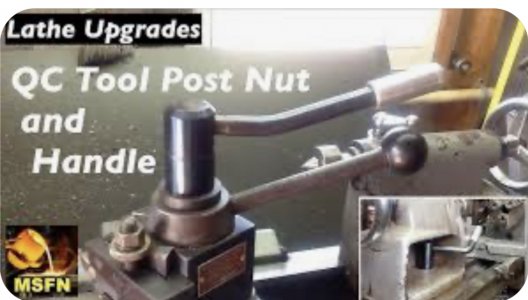- Joined
- Dec 3, 2017
- Messages
- 1,910
I sometimes see people have made a locking handle for their quick change tool holders, to replace the nut supplied as standard. I’ve recently decided to make one.
But here’s my problem: I watch a ton of YouTube. Stay with me here. That’s a problem, but not the problem.
I seem to constantly be needing a different toolbit, in a different orientation. Which means I’m forever adjusting my toolholder block. Which means I’m constantly losing any reference datum I had. This, to me, is my problem.
I think perhaps I should not be making a special locking handle, because I should instead be leaving the tool holder block alone, in order to keep my zero reference. Isn’t that (generally speaking) best practice?
So other than being smarter, which is very unlikely. Is this fundamentally an “order of operations” or “planning” failure?
An example may be a part that has a larger OD on both ends. I’ve got a left and right inside corner. I’ll invariably switch out the tool, and reorient the tool block doing this job. Somewhere in there, I’ll lose any reference to what’s already been done. My carriage stop will now be in the wrong place, and my dial indicators will have to be reset.
And now we’re back to the YouTube mention. I almost never see anyone reorient their tool holder. So I’m assuming it’s either unnecessary, or bad practice. Is it possible I’ve just taught myself a bad habit?
Here’s an example of the extra handle I began this thread talking about.
What say you folks? Are you reorienting your tool block so often that you need an extra handle? Or does your tool block stay locked in position 99.9 percent of the time?
But here’s my problem: I watch a ton of YouTube. Stay with me here. That’s a problem, but not the problem.
I seem to constantly be needing a different toolbit, in a different orientation. Which means I’m forever adjusting my toolholder block. Which means I’m constantly losing any reference datum I had. This, to me, is my problem.
I think perhaps I should not be making a special locking handle, because I should instead be leaving the tool holder block alone, in order to keep my zero reference. Isn’t that (generally speaking) best practice?
So other than being smarter, which is very unlikely. Is this fundamentally an “order of operations” or “planning” failure?
An example may be a part that has a larger OD on both ends. I’ve got a left and right inside corner. I’ll invariably switch out the tool, and reorient the tool block doing this job. Somewhere in there, I’ll lose any reference to what’s already been done. My carriage stop will now be in the wrong place, and my dial indicators will have to be reset.
And now we’re back to the YouTube mention. I almost never see anyone reorient their tool holder. So I’m assuming it’s either unnecessary, or bad practice. Is it possible I’ve just taught myself a bad habit?
Here’s an example of the extra handle I began this thread talking about.
What say you folks? Are you reorienting your tool block so often that you need an extra handle? Or does your tool block stay locked in position 99.9 percent of the time?


